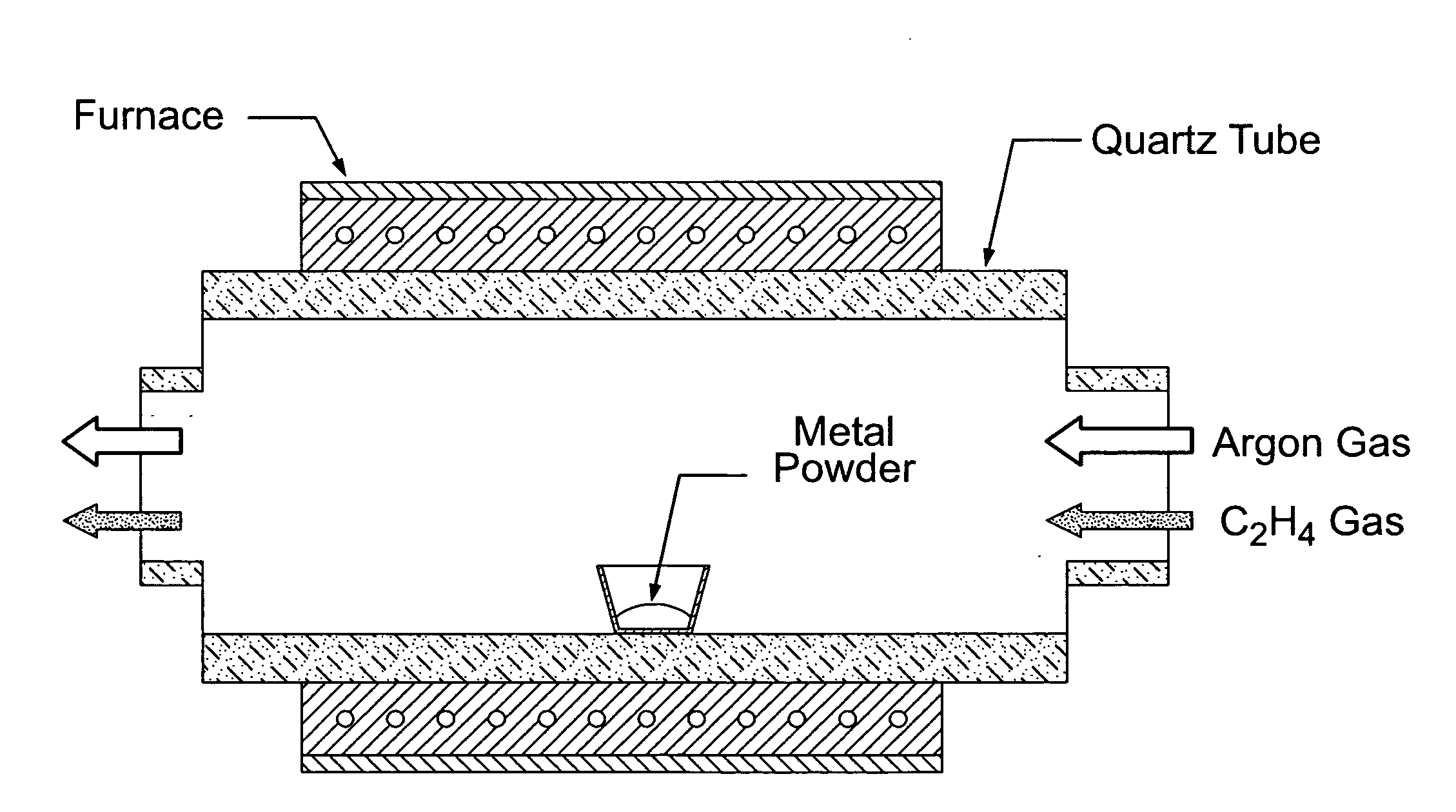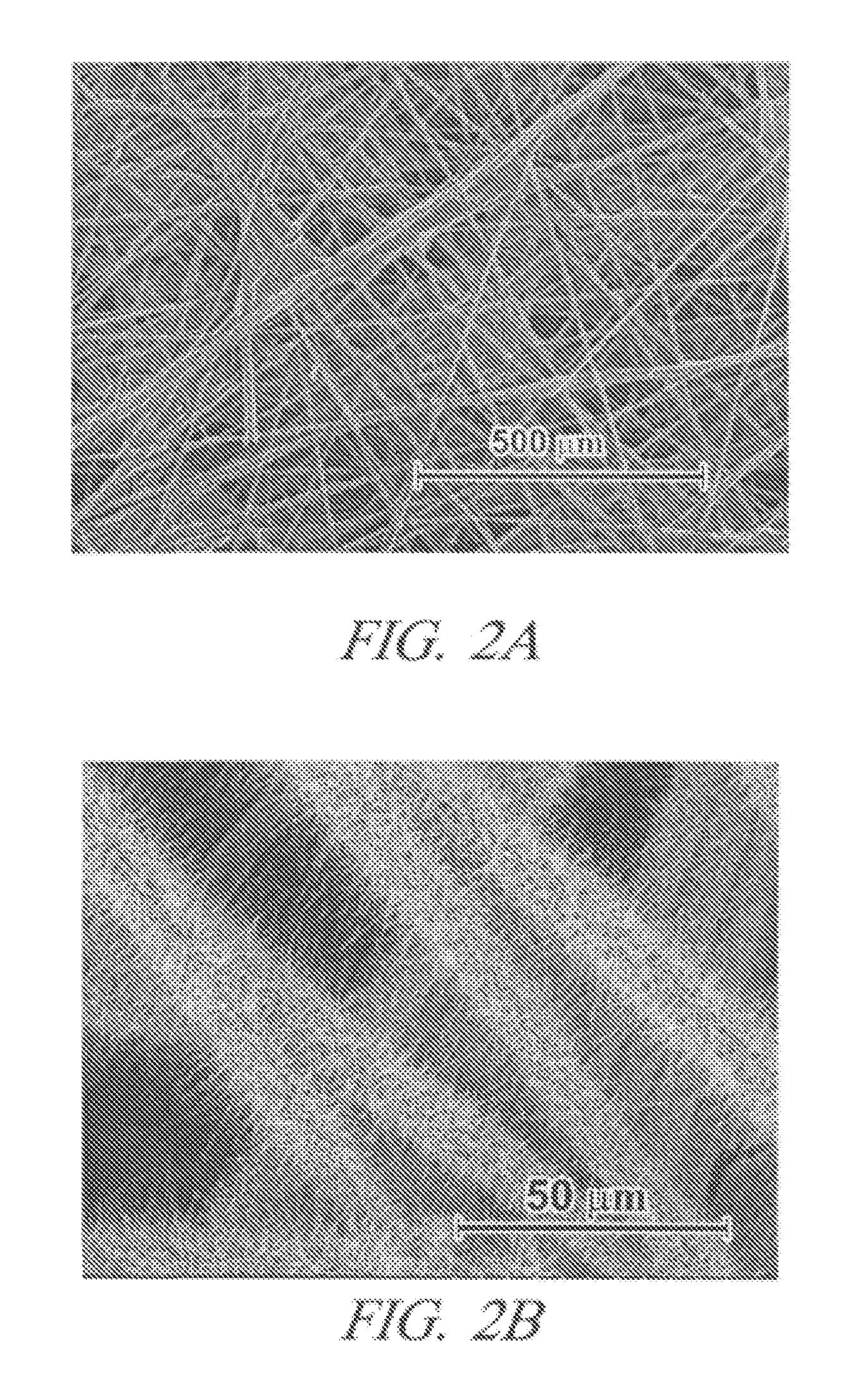Nanowire supported catalysts for fuel cell electrodes
a fuel cell electrode and catalyst technology, applied in cell components, nuclear engineering, electrochemical generators, etc., can solve the problems of many platinum nanoparticles trapped in deep cracks in carbon black, and achieve the effect of carrying and dispersing particles
- Summary
- Abstract
- Description
- Claims
- Application Information
AI Technical Summary
Benefits of technology
Problems solved by technology
Method used
Image
Examples
experimental practices
Synthesis of Metal Oxide and Carbon-coated Metal Nanowires
1. Synthesis
[0037]Metal oxide nanowires were synthesized by a thermal evaporation method. A schematic diagram of synthesis apparatus and gas flow is shown in FIG. 1. An alumina boat loaded with pure commercial tin (Sn) powders (in the case of SnO2 nanowires or carbon-coated Sn nanowires) was placed in the middle of a quartz tube and inserted into a horizontal tube furnace. In experiments in which nanowires were grown on a carbon paper substrate, a small piece of carbon paper (not illustrated in FIG. 1) was placed in the alumina boat beside the metal powder. The reaction chamber was heated to a temperature in the range of 800° to 900° C. rapidly (about 15 min) from room temperature under a flowing Ar atmosphere. A grade of argon gas was used that contained sufficient oxygen (a few hundred parts-per-million) to oxidize the tin powder to SnO2 nanowires. In the case of carbon-coated Sn nanowires, ethylene gas (C2H4) was flowed i...
specific examples
Example 1
SnO2 Nanowires-Carbon Paper Composite as an Electrode
[0048]This example demonstrates that nanowires may be grown directly on carbon paper and that platinum particles (for example) may then be deposited selectively on the nanowires to improve platinum utilization by securing the electronic route from platinum particle to the supporting electrode in, for example, PEM fuel cells. The deposition of platinum on SnO2 nanowires is described above. But it is of practical importance to demonstrate that the nanowires-carbon paper composite is really an electrode, i.e., the nanowires are in electrical contact with the carbon fibers of the carbon paper.
[0049]The electrical contact between SnO2 nanowires and the carbon fibers of the carbon paper were characterized by cyclic voltammetry in 5 mM K3Fe(CN)6 aqueous solution in 0.5 M K2SO4 in a standard three-electrode electrochemical cell. The working electrode was carbon paper or SnO2 nanowires electrode. A Ag / AgCl (3M KCl) electrode and a...
example 2
Characterization of Deposited Pt Nanoparticles by Cyclic Voltammetry
1. Pt Nanoparticles Supported SnO2 Nanowire Catalysts Prepared by an Electrochemical Method:
[0050]Cyclic voltammogram data illustrating electrocatalytic nature of Pt nanoparticles electrodeposited on SnO2 nanowires in Ar-saturated 0.5 M H2SO4 aqueous solution at room temperature are presented FIG. 6A. The cyclic voltammetric behavior is reproducible and represents absorption and desorption of hydrogen. A reduction peak centered at 0.5 V can be observed during the negative-going potential sweep (FIG. 6A). This reduction peak can be attributed to the reduction of platinum oxide. This feature of the curve is consistent with those of the cyclic voltammogram curves for Pt electrodes. Thus, it may also be concluded that the platinum nanoparticles have a very clean active surface. This result demonstrates that the Pt nanoparticles thus deposited show higher utilization and are in electrical contact with the underlying SnO2...
PUM
 Login to View More
Login to View More Abstract
Description
Claims
Application Information
 Login to View More
Login to View More - R&D
- Intellectual Property
- Life Sciences
- Materials
- Tech Scout
- Unparalleled Data Quality
- Higher Quality Content
- 60% Fewer Hallucinations
Browse by: Latest US Patents, China's latest patents, Technical Efficacy Thesaurus, Application Domain, Technology Topic, Popular Technical Reports.
© 2025 PatSnap. All rights reserved.Legal|Privacy policy|Modern Slavery Act Transparency Statement|Sitemap|About US| Contact US: help@patsnap.com



